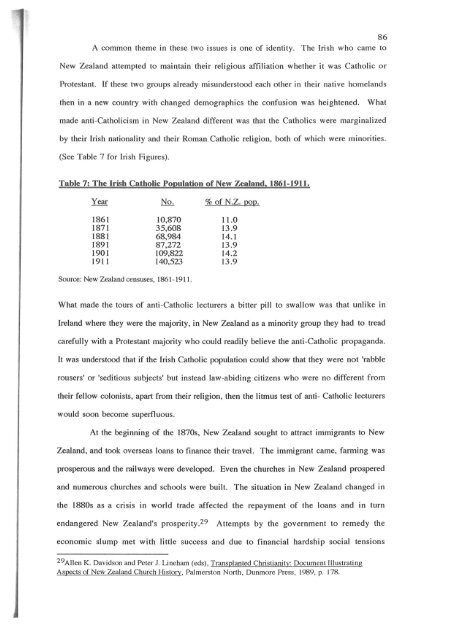TRANSPLANTED IRISH INSTITUTIONS - University of Canterbury
TRANSPLANTED IRISH INSTITUTIONS - University of Canterbury
TRANSPLANTED IRISH INSTITUTIONS - University of Canterbury
Create successful ePaper yourself
Turn your PDF publications into a flip-book with our unique Google optimized e-Paper software.
86<br />
A common theme in these two issues is one <strong>of</strong> identity. The Irish who came to<br />
New Zealand attempted to maintain their religious affiliation whether it was Catholic or<br />
Protestant. If these two groups already misunderstood each other in their native homelands<br />
then in a new country with changed demographics the confusion was heightened.<br />
What<br />
made anti-Catholicism in New Zealand different was that the Catholics were marginalized<br />
by their Irish nationality and their Roman Catholic religion, both <strong>of</strong> which were minorities.<br />
(See Table 7 for Irish Figures).<br />
Table 7: The Irish Catholic Population <strong>of</strong> New Zealand, 1861-1911.<br />
% <strong>of</strong> N.Z. wp.<br />
1861<br />
1871<br />
1881<br />
1891<br />
1901<br />
1911<br />
10,870<br />
35,608<br />
68,984<br />
87,272<br />
109,822<br />
140,523<br />
11.0<br />
13.9<br />
14.1<br />
13 .9<br />
14.2<br />
13.9<br />
Source: New Zealand censuses, 1861-1911.<br />
What made the tours <strong>of</strong> anti-Catholic lecturers a bitter pill to swallow was that unlike in<br />
Ireland where they were the majority, in New Zealand as a minority group they had to tread<br />
carefully with a Protestant majority who could readily believe the anti-Catholic propaganda.<br />
It was understood that if the Irish Catholic population could show that they were not 'rabble<br />
rousers' or 'seditious subjects' but instead law-abiding citizens who were no different from<br />
their fellow colonists, apart from their religion, then the litmus test <strong>of</strong> anti- Catholic lecturers<br />
would soon become superfluous.<br />
At the beginning <strong>of</strong> the 1870s, New Zealand sought to attract immigrants to New<br />
Zealand, and took overseas loans to finance their travel. The immigrant came, farming was<br />
prosperous and the railways were developed. Even the churches in New Zealand prospered<br />
and numerous churches and schools were built. The situation in New Zealand changed in<br />
the 1880s as a crisis in world trade affected the repayment <strong>of</strong> the loans and in tum<br />
endangered New Zealand's prosperity.29<br />
Attempts by the government to remedy the<br />
economic slump met with little success and due to financial hardship social tensions<br />
29 Allen K. Davidson and Peter J. Lineham (eds), Transplanted Christianity: Document Illustrating<br />
Aspects <strong>of</strong> New Zealand Church History, Palmerston North, Dunmore Press, 1989, p. 178.
















